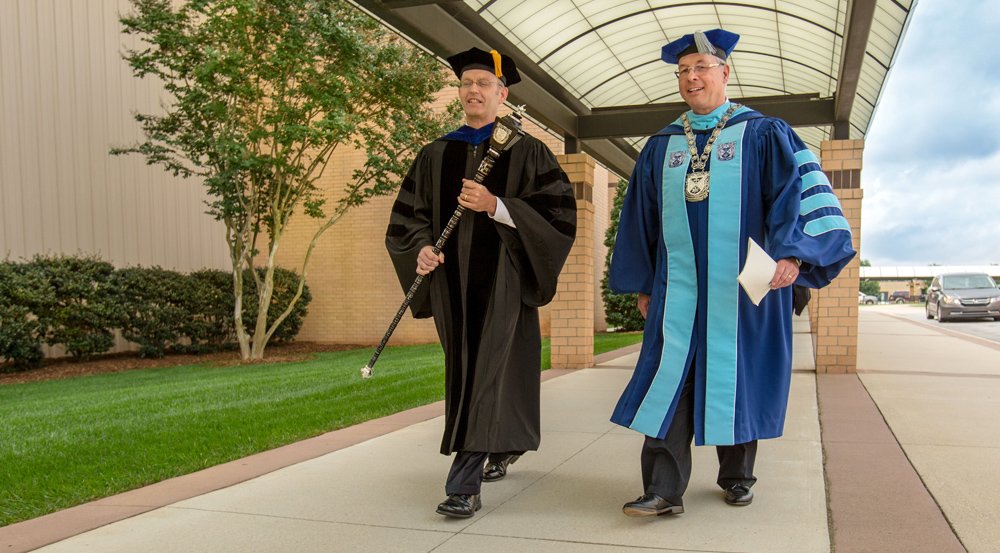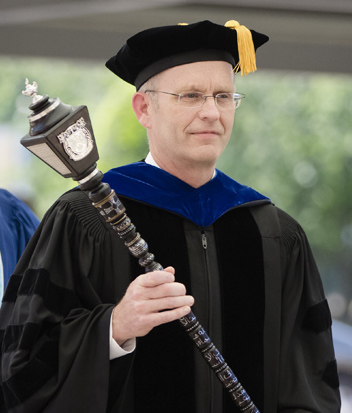The Mace
Crafting a new university mace that embodies the heritage, heart and mission of the institution
I’ve done extensive work with academic visual identity: all the visual elements that represent a university, from the architecture to the crest. It’s an area steeped in tradition and heritage and ritual. Three elements are reflected in the photo below: distinctive regalia, the chain of office worn by the president, and the mace carried by the chief academic official. The chain of office is worth noting; it was cast in solid silver then enameled. The focus of this article, however, is the ceremonial mace.

A project like this starts with research: immersion in the history of the institution. The finished product must be deeply infused with meaning; every design element and material selection should hold meaning and significance. I became captivated by the idea of building around an object in the university archives: an elaborate walking stick, a gift from a Lebanese missionary to a past president. The walking stick is magnificent, Coptic in origin, turned and carved from an exotic black wood and covered with silver, brass and bronze decoration. The primary decorative element is the ten commandments, written in Arabic. Most of the decoration is pinwork, where lines are created by drilling a series of tiny holes, inserting fine silver wire, and clipping it off at the surface.  There are also twisted-wire ropes inlaid in bands. I developed a proposal for a mace built out of the staff, with a head added on top and a pommel on the bottom. Administration gave approval and I got to work. I was able to identify the staff material as African Blackwood, a rare and expensive wood that comes from a small, bushy tree. My first challenge was that it’s only available in very small sizes. I finally made contact with a lady in Michigan who imports blackwood from her uncle, a missionary in Africa. She was able to provide me with some of his best and largest cuts, including a few impossibly large blocks. Blackwood is extremely dense and works more like metal than wood. Normal woodworking tools are not up to the task, as I discovered when I first tried to cut a small block on a bandsaw and wore the teeth off the blade. The head of the staff is made of three pieces of blackwood, with a turned top and bottom, mounted on an angular square block.
There are also twisted-wire ropes inlaid in bands. I developed a proposal for a mace built out of the staff, with a head added on top and a pommel on the bottom. Administration gave approval and I got to work. I was able to identify the staff material as African Blackwood, a rare and expensive wood that comes from a small, bushy tree. My first challenge was that it’s only available in very small sizes. I finally made contact with a lady in Michigan who imports blackwood from her uncle, a missionary in Africa. She was able to provide me with some of his best and largest cuts, including a few impossibly large blocks. Blackwood is extremely dense and works more like metal than wood. Normal woodworking tools are not up to the task, as I discovered when I first tried to cut a small block on a bandsaw and wore the teeth off the blade. The head of the staff is made of three pieces of blackwood, with a turned top and bottom, mounted on an angular square block.
The head has two flat silver plates, engraved with the university hymn and the university creed; on opposing sides are a cast silver crest and shield. On top is a silver lamp, derived from the Lamp of Truth shown on the shield. I created the dimensional silver elements in 3D software; given the time constraints, I sent the file out to Best Cast to be printed on a 3D printer, then cast in de-ox silver (a sterling alloy resistant to tarnishing). They delivered rough castings, which I polished and enameled. I engraved the flat elements on a rotary engraver, which gives elegant sparkling text. The pommel is needed on the bottom as a counterbalance to the very heavy top unit. I cast the initial form out of two pounds of de-ox silver. The finished shape was turned on a lathe, then threaded for attachment to the staff. It’s my favorite kind of project: one that combines a range of challenging materials while demanding finest craftsmanship.